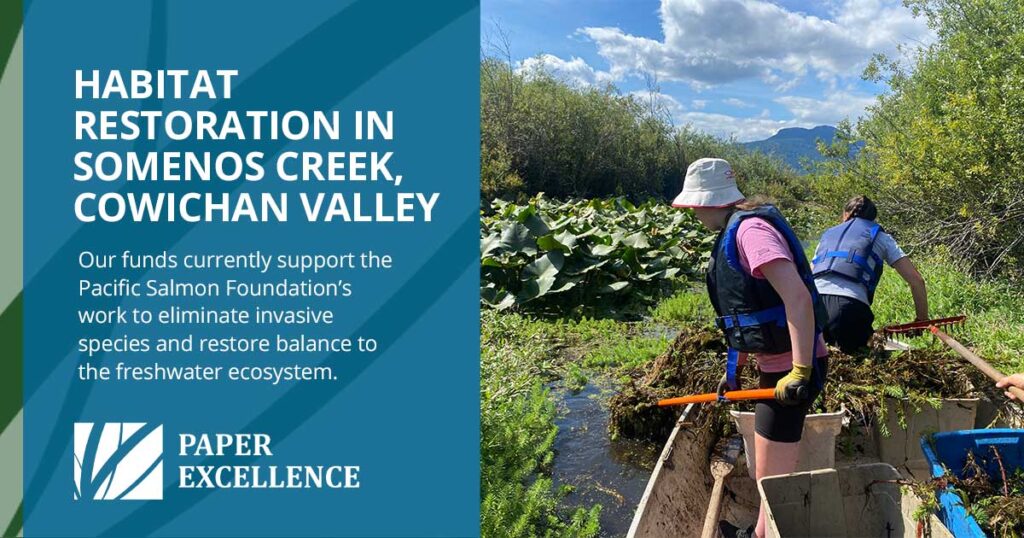
Invasive species are always a serious consideration when evaluating the suitability of habitat for Pacific salmon, as they can interfere with the balance of the ecosystem. An invasive plant of high concern on Vancouver Island is Parrot’s Feather, an aquatic weed grows quickly through the summer months and can rapidly spread to cover most of the open surface area of a creek. Parrot’s Feather is subtropical in origin but can survive the climate extremes of the Cowichan Valley and has firmly established itself in Somenos Creek near Duncan.
Dense growth of aquatic weeds like Parrot’s Feather can drastically reduce the levels of dissolved oxygen in a body of water, and this effect has been recorded in Somenos Creek. A critical water quality parameter for salmon survival in the fall spawning migration period is dissolved oxygen, and these oxygen levels typically do not recover in the creek until several months later, meaning that conditions in Somenos Creek are not survivable for salmonids until mid-November to early December. Salmon spawn in the inflow creeks into Somenos Lake, but salmon can only access the inflow creeks by moving through Somenos Creek. It is unsurprising, then, that the number of spawning salmon in the watershed is lower than in the past. Concerningly, no observations of chum have been made in the past three years.
This issue is a primary concern for the Somenos Marsh Wildlife Society, among other ecological restoration efforts in the S’amunu\Somenos watershed. Thanks to funding from the Community Salmon Program this spring, the group has been able to purchase an invaluable piece of equipment called a U6 Logger that will hopefully inform the best plan of action going forward to tackling this invasive species.
Removal of Parrot’s Feather from 2-4m sections of the river using an aquatic mower have been underway throughout the summer. The U26 logger will then be used to monitor dissolved oxygen and temperature in these cleared channels, as well as sections of the river where Parrot’s Feather remains. The objective is to see if the control/removal method can be applied to all of Somenos Creek to improve oxygen levels for migrating salmon in the fall, with the hopes that improved oxygen levels will also extend the foraging and refuge potential of the creek for fry and smolts in late spring and summer.
The advancement of this project thanks to funders like Paper Excellence strongly benefits the community, including the volunteers who support the society, as well as students from local schools who can experience hands-on education while getting involved in the project. Thanks to Somenos Marsh Wildlife Society’s awareness efforts, members of the community and stakeholders are well versing in this important issue. Cowichan Tribes are a partner in the group’s GreenStreams strategy, and the society also works closely with the Municipality of North Cowichan to address issues in Somenos Creek.
Habitat Restoration and Monitoring in Somenos Creek in Cowichan Valley
Pacific Salmon Foundation is a nonprofit environmental organization dedicated to the conservation and restoration of wild Pacific salmon and their habitats in British Columbia and the Yukon. They work with all members of the ‘salmon community’ to advance the collective efforts, promote awareness of this keystone species, and guide the sustainable future of wild Pacific salmon and their habitat. As a vocal advocate for salmon, PSF helps action priorities that support the conservation of this vital ecological resource.
Learn more about Paper Excellence’s support of the Pacific Salmon Foundation:
- Paper Excellence donates $50,000 to the Pacific Salmon Foundation – Paper Excellence Group
- Paper Excellence Canada contributes $100,000 to advance salmon restoration across B.C. – Paper Excellence Group
- Championing change for salmon habitat restoration – Paper Excellence Group
- Reviving our Local Salmon Habitat in North Vancouver – Paper Excellence Group
- Pacific Salmon Foundation Update – Hatchery Upgrades at Chapman Creek on the Sunshine Coast
- Pacific Salmon Foundation Update – Monitoring Key Salmon Indicators with Citizen Science at Pender Harbour
